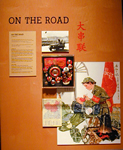
History of Cultural Revolution
Right to Rebel
On the Road
Living
Culture
Daily Life
Learning
The Countryside
Looking Back
Sidney Rittenberg Presentation
Links
 > View Large < |
ON THE ROAD "The trains were packed to the point that there were five levels of seating: below the seats, on the seats, on the tea table, on the backs of the seats, on the luggage racks." female student "Mao was so different from normal people. He was so great and so red...like a light." male student |
LINKING UP
During the first few months of the Cultural Revolution, Mao encouraged students to travel, to "link up" with other revolutionary groups and exchange experiences. Armed with their Red Books and Mao badges, students swarmed free onto the trains. This was the first time in their lives that most students were able to visit other parts of China. In new cities, traveling students found free meals and lodging with group members. More than ten million students traveled to Beijing. For many of them, seeing Chairman Mao at mass rallies was the high point of their lives.
LONG MARCH
By late 1966, students had overloaded the transportation systems. To show their endurance and commitment, many students formed "Long March" groups, in memory of the Communist Party's 8,000-mile Long March of 1935. Students traveled on foot for hundreds of miles, often visiting important sites in revolutionary history.
This page
last updated
September 25, 2002
All material © 1998-2002
Burke Museum of Natural History & Culture
University of Washington, Box 353010
Seattle, WA 98195
This site best viewed at 800 x 600
using IE 5.0 or above.
